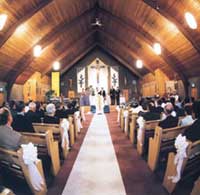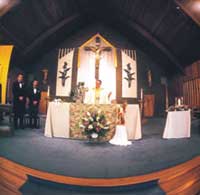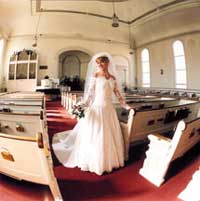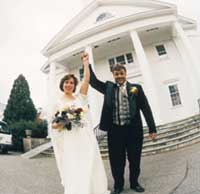Fisheyes For Impact
New Lenses Add Unique Touch To Weddings
Wedding photography has changed greatly in the last few years, and I expect that trend to continue. The flood gates burst back in the late '80s with a new, more photojournalistic approach to the "Satin Jungle." Gone were the cornball posed shots of the bride's dad holding out his empty pockets; those were replaced with new "real" candids that were captured moments instead of set up photo opportunities. Next, pros began packing 35mm cameras next to their medium format gear, a practice that would have previously been unthinkable. Recently, black and white high grain photos have become hot sellers. And in the continuing quest for Joe Photographer to differentiate himself from the masses, lenses from super wide to very long have found their way into photographer's bags, all in the name of a unique look. |
|||
Enter the fisheye lens, which
is different and imparts a look to a photo that you can't get any
other way, even digitally. You might be able to make a swoopy curve on
your computer, but you've gotta have the extreme wide angle view
to get all that information on the negative in the first place. Score
one for the design team. |
|||
A quick call to Tamron/ Bronica
was all that was needed to put a fisheye in my hands the next day. I shoot
most of my wedding photography with a Bronica SQ-A, so they fitted me
out with the lens for that model. They also make one for the Bronica ETR
series. |
|||
What's The Point
Of A Fisheye? According to Nikon's web site, these lenses
were initially designed for industrial and scientific purposes, but of
course something this cool would automatically be pounced on by photographers
looking for a new way to expand their vision. As it applies to wedding
photography, the most common approach that I've seen is shooting
panoramic church interiors during the ceremony. The results are directly
proportional to what the church looks like, with big cathedrals winning
the best looking battle. Of course, that's not all you can do with
them, as I discovered over the three weddings I photographed with the
aqua-optic in my bag. I used it in the church, at the reception, and inside
the limo. Wedding shooters are always looking for a different approach,
and this is one sure-fire way of getting it. |




































